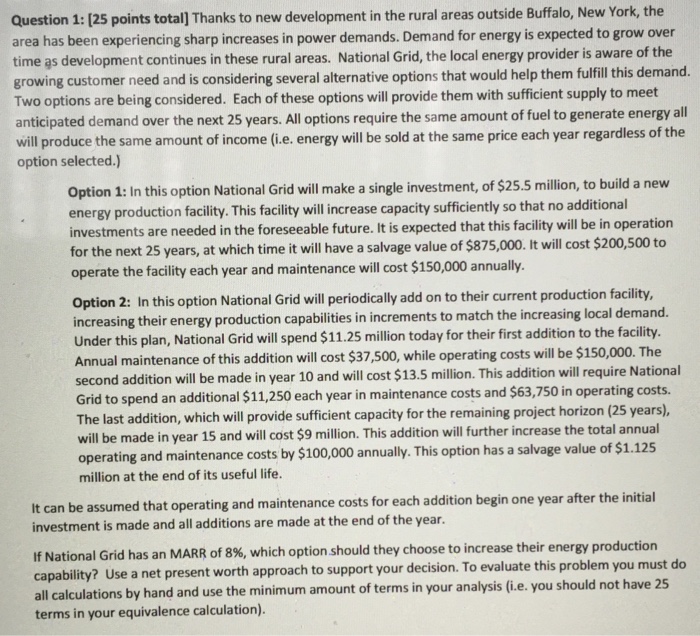Thanks to new development in the rural areas outside Buffalo, New York, the area has been experiencing sharp increases in power demands. Demand for energy is expected to grow over time as development continues in these rural areas. National Grid, the local energy provider is aware of the growing customer need and is considering several alternative options that would help them fulfil this demand. Two options are being considered. Each of these options will provide them with sufficient supply to meet anticipated demand over the next 25 years. All options require the same amount of fuel to generate energy all will produce the same amount of income (i.e. energy will be sold at the same price each year regardless of the option selected.) Option 1: In this option National Grid will make a single investment, of $25.5 million, to build a new energy production facility. This facility will increase capacity sufficiently so that no additional investments are needed in the foreseeable future. It is expected that this facility will be in operation for the next 25 years, at which time it will have a salvage value of $875,000. It will cost $200, 500 to operate the facility each year and maintenance will cost $150,000 annually. Option 2: In this option National Grid will periodically add on to their current production facility, increasing their energy production capabilities in increments to match the increasing local demand. Under this plan, National Grid will spend $11.25 million today for their first addition to the facility. Annual maintenance of this addition will cost $37, 500, while operating costs will be $150,000. The second addition will be made in year 10 and will cost $13.5 million. This addition will require National Grid to spend an additional $11, 250 each year in maintenance costs and $63, 750 in operating costs. The last addition, which will provide sufficient capacity for the remaining project horizon (25 years), will be made in year 15 and will cost $9 million. This addition will further increase the total annual operating and maintenance costs by $100,000 annually. This option has a salvage value of $1, 125 million at the end of its useful life. It can be assumed that operating and maintenance costs for each addition begin one year after the initial investment is made and all additions are made at the end of the year. If National Grid has an MARR of 8%, which option should they choose to increase their energy production capability? Use a net present worth approach to support your decision. To evaluate this problem you must do all calculations by hand and use the minimum amount of terms in your analysis (i.e. you should not have 25 terms in your equivalence calculation)







